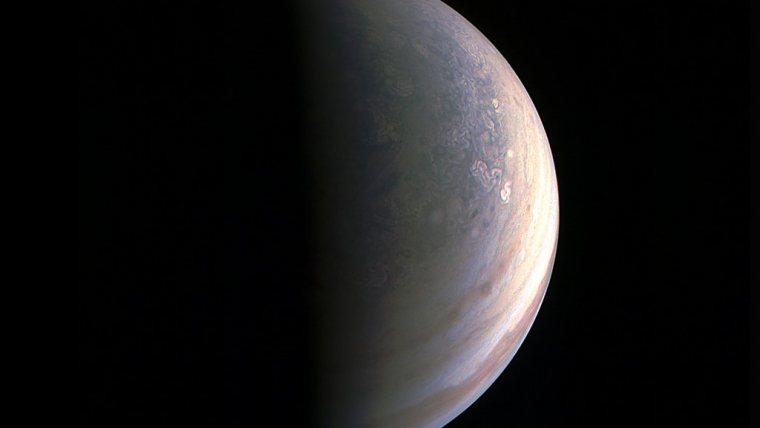| News / Space News |
Jupiter's North Pole Unlike Anything Encountered in Solar System
NASA | SEPTEMBER 7, 2016
NASA's Juno spacecraft has sent back the first-ever images of Jupiter's north pole, taken during the spacecraft's first flyby of the planet with its instruments switched on. The images show storm systems and weather activity unlike anything previously seen on any of our solar system's gas-giant planets.

NASA's Juno spacecraft captured this view as it closed in on Jupiter's north pole, about two hours before closest approach on Aug. 27, 2016. ![]()
First glimpse of Jupiter's north pole, and it looks like nothing we have seen or imagined before. It's bluer in color up there than other parts of the planet, and there are a lot of storms.
There is no sign of the latitudinal bands or zone and belts that we are used to -- this image is hardly recognizable as Jupiter. We're seeing signs that the clouds have shadows, possibly indicating that the clouds are at a higher altitude than other features.
These first infrared views of Jupiter's north and south poles are revealing warm and hot spots that have never been seen before.
Among the more unique data sets collected by Juno during its first scientific sweep by Jupiter was that acquired by the mission's Radio/Plasma Wave Experiment (Waves), which recorded ghostly- sounding transmissions emanating from above the planet.
These radio emissions from Jupiter have been known about since the 1950s but had never been analyzed from such a close vantage point.
"Jupiter is talking to us in a way only gas-giant worlds can," said Bill Kurth, co-investigator for the Waves instrument from the University of Iowa, Iowa City. "Waves detected the signature emissions of the energetic particles that generate the massive auroras which encircle Jupiter's north pole. These emissions are the strongest in the solar system. Now we are going to try to figure out where the electrons come from that are generating them."
YOU MAY ALSO LIKE



